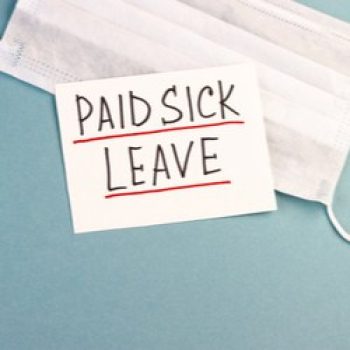New York State’s Paid Sick/Safe Leave Law took effect on September 30, 2020. It applies to all New York employers–nonprofit and for-profit. Under it, employees may start using paid sick and safe leave on January 1, 2021.
In response to the enactment of New York State’s law, New York City also amended its own Paid Safe and Sick Leave Law and on October 21, 2020, New York City updated its Notice of Employee Rights which must be distributed to all employees in both English and the employee’s primary language –once the document has been translated by New York City’s Department of Consumer and Worker Protection (“DCWP”) into that language on its website. Below are some questions and answers relating to the New York City law which covers all employers–non-profit and for-profit– with employees working in New York City.
When Does the Amendment to NYC’s Law Take Effect?
The amendment to New York City’s Paid Safe and Sick Leave law (“PSSL”) took effect on September 30, 2020. Specifically, as of September 30, 2020, employers must: 1) allow employees to use safe and sick leave as it is accrued; 2) reimburse employees for costs associated with getting documentation from a health care provider or other provider after the employee has taken more than three consecutive workdays of sick/safe leave; and 3) list on employees’ paystubs each pay period (or another document issued during each pay period) the amounts of accrued and used leave and the total balance of accrued leave. With respect to the paystub information requirement, employers that could not satisfy that requirement by September 30, 2020 but are working in good faith on implementation had until November 30, 2020 to ensure compliance without a penalty.
How Much Leave is Required?
Just like New York State’s Paid Sick/Safe Leave law, under PSSL, the amount of leave required to be provided depends on the number of employees and/or net income of the organization:
- Employers with 100 or > employees in any calendar year must provide covered employees with: Up to 56 hours of paid sick/safe leave each calendar year;*
- Employers with fewer than five employees and net income of more than $1 million in prior calendar year: Up to 40 hours of paid sick/safe leave in each calendar year;*
- Employers with between 5-99 employees in any calendar year: Up to 40 hours of paid sick/safe leave in each calendar year; and
- Employers with fewer than five employees and less than $1 million in net income in prior calendar year: Up to 40 hours of unpaid sick/safe leave in each calendar year. * These two requirements take effect on January 1, 2021.
What Can the Leave Be Used For?
Sick leave may be used for medical, health and emergency safety reasons. Specifically, leave may be taken: 1) for an employee’s health, including to get medical care or to recover from illness or injury; 2) to care for a family member who is ill or has a medical appointment; 3) when an employee’s workplace or child’s school or childcare provider closes due to a public health emergency; or 4) for the safety of an employee or employee’s family member because of domestic violence, unwanted sexual contact, stalking, or human trafficking. In the case of COVID-19, employees may use this leave if they feel ill or show COVID-19 symptoms, get tested for the flu or COVID-19, are under quarantine or self-isolating for preventative purposes, or are caring for a family member under a mandatory or precautionary order of quarantine. (This leave is not limited, however, to COVID-related illness and is separate and apart from New York State’s own COVID-19-Paid Sick-Leave Law).
May an Employer Front-Load the Leave at the Beginning of a Calendar Year Rather than Require Employees to Accrue the Leave?
Yes. An employer may elect to provide its employees with the total amount of sick/safe leave required to fulfill its obligations at the calendar year start, provided, however that the employer may not reduce or revoke any such leave based on the number of hours actually worked by an employee during the calendar year.
May an Employer Require Advance Notice for the Leave?
Yes, where the need for leave is foreseeable, an employer may require at least 7 days’ advance notice, but if the need for leave is unforeseeable, then the employee needs to give notice of leave as soon as practicable (reasonable). The employer may also require an employee to provide written verification that the leave was taken for authorized sick or safe leave purposes.
May an Employer Require an Employee to Provide Documentation about the Nature of the Employee’s Illness as a Condition of Providing Sick Leave?
No, but an employer is permitted to require an employee to provide documentation from a licensed health care provider confirming the amount of sick leave used and whether the leave was used for an authorized purpose under the law: 1) after an employee uses more than three (3) consecutive workdays as sick/safe leave (and no less than seven (7) days after the employee returns to work under NYS law); and 2) for safe leave, reasonable documentation from a social service provider, attorney, court, law enforcement, clergy member, or notarized letter by employee indicating the need for safe leave (but not setting out the reason for the leave). Under PSSL, employers may not, however, require that the documentation specify the reason for safe or sick leave. NYC’s DCWP — which enforces this law– advises employees not to include details of their medical or personal situation in the documentation provided to the employer nor the reason for taking safe leave.
Does the Law Require Employers to Allow Carry Over Unused Sick/Safe Leave?
Yes. Remember, however, that:
- An employer with fewer than 100 employees may limit the use of sick leave to 40 hours per calendar year; and
- An employer with 100 or more employees may limit the use of sick leave to 56 hours per calendar year.
Additionally, if the leave is front-loaded at the beginning of the calendar year fully available for use without the need to accrue it, there would not be a reason for an employee to carry it over.
Is the Leave Job-Protected and Are Employees Protected From Retaliation for Taking Leave?
Yes, an employee must be restored to their position following return from safe/sick leave with the same pay and other terms and conditions of employment. The PSSL prohibits employers from discriminating or retaliating against an employee for exercising their rights, including, but not limited to, for requesting and using sick leave and reporting violations. More specifically, the amendment to the PSSL prohibits employers from taking an adverse action that penalizes an employee for, or is reasonably likely to deter an employee from, exercising or attempting to exercise their rights under the law. An “adverse action” is broadly defined to include, but not be limited to, threats, intimidation, discipline, reduction in hours or pay, informing another employer of an employee’s exercise of rights, blacklisting, and maintaining or applying an absence control policy that counts protected leave for safe/sick time as an absence that may lead to or result in an adverse action. Adverse actions include actions related to perceived immigration status or work authorization (like threatening to report an undocumented worker to the authorities).
What Information Must an Employer Provide to an Employee About Their Rights?
Employers must provide employees with a written safe and sick leave policy that explains how to use their benefits and inform employees of the amount of their sick/safe leave use and balance. Employers may not require an employee to find coverage for that employee in order to take the sick/safe leave. Additionally, the law prohibits retaliation against employees, as noted above. (Remember too, that under NYS law, employers must also provide a summary of the accrued and used sick leave amounts, if requested by the employee, within three business days of such request.)
Are There Additional Penalties Under the Amendment to NYC’s Paid Sick/Safe Leave Law?
The amendment to the PSSL includes a new remedy: For each employee covered by an employer’s official or unofficial policy or practice of not providing or refusing to allow the use of accrued safe/sick time, $500.
As you may recall, NYC Department of Consumer and Worker Protection’s Office of Labor Policy & Standards (OLPS) enforces the PSSL. Employers who fail to provide compensation for the leave may owe three times the wages that should have been paid (or $250, whichever is greater), fines for each instance where an employer denies the leave or unlawfully conditions the leave upon an employee searching for or finding a replacement worker, or for each instance an employer requires an employee to work additional hours without the mutual consent of such employer and employee to make up for the original hours during which such employee is absent. Employers are also subject to civil penalties on a per employee basis.
Employees do not have a private right of action to proceed in court but the corporation counsel may bring a civil action in court to enforce any order of OLPS or seek injunctive relief (to stop an employer from violating the law) or to sue for a pattern or practice of violations. If a pattern or practice violation of the law is found, an employer may be subject to civil penalties of up to $15,000 plus additional relief of $500 to each employee covered by an employer’s policy or practice of not providing or refusing to allow the use of earned time.
Additionally, employers who did not provide employees with a proper notice of employee rights may receive a civil penalty of no more than fifty dollars, per each employee who was not given appropriate notice.
Finally, an employer who retaliates against an employee for exercising their rights may be liable for an employee’s lost wages and benefits, a fine, and equitable relief (like reinstatement in the case of an employee who has been unlawfully terminated).
What Should Organizations with NYC Employees Do Now?
Review, and where needed, update your employee handbooks to address New York City’s amended paid sick/safe leave law and distribute those updated policies together with the updated Notice of Employee Rights (distribute notices electronically, if employees are working remotely). Get a signed acknowledgement of receipt (or “read receipt”) of the notice of employee rights, and train your managers regarding employees’ rights under this law, including to be free from retaliation. Review payroll records to ensure they are consistent with the law’s new requirements.
If you seek assistance with updating your policies, training your managers on the new laws, and advising on compliance or have any questions, please contact Lisa M. Brauner, Esq., Perlman & Perlman LLP, Head of Employment Law practice, lisa@perlmanandperlman.com, 212-889-0575.
The information provided in this document does not constitute legal advice, and is not intended to substitute for legal counsel.
- Perlman & Perlmanhttps://perlmanandperlman.com/author/nancyisrael/
- Perlman & Perlmanhttps://perlmanandperlman.com/author/nancyisrael/
- Perlman & Perlmanhttps://perlmanandperlman.com/author/nancyisrael/
- Perlman & Perlmanhttps://perlmanandperlman.com/author/nancyisrael/







